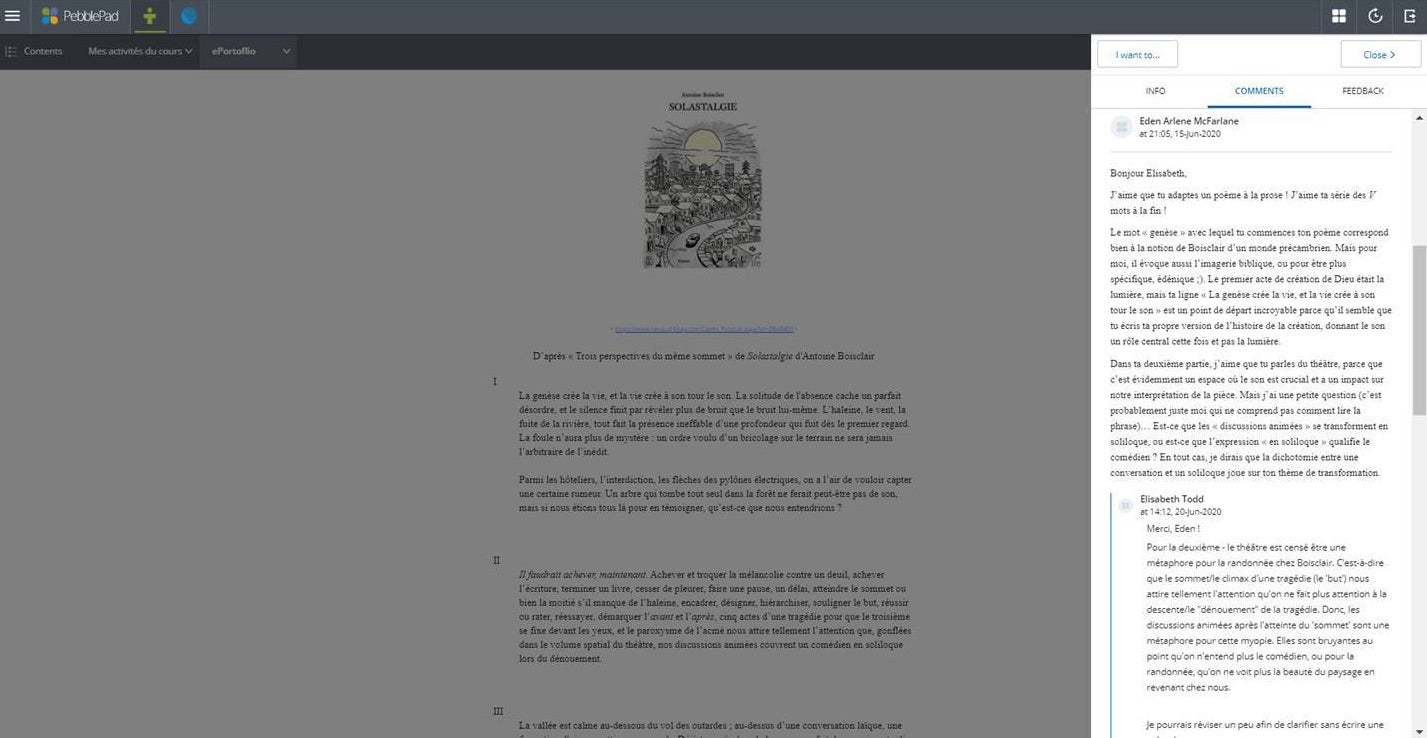General Information
Instructor: Élise Lepage
Class: FR 671
Élise Lepage introduced PebblePad portfolios to her graduate courses to facilitate student engagement between their peers and instructor, and challenge students to reflect and be creative in their work. Each element of their portfolio was shared throughout the term to be peer-reviewed through the feedback tool in PebblePad.
Assignment Description
The portfolio is a research project made up of four separately evaluated elements, aiming at ensuring that each student develops skills in the creation and in literary and visual criticism. The student can choose a subject for their portfolio or choose a separate subject for each element.
| Portfolio | Literary Element | Visual Element |
|---|---|---|
| Creation | Creation of a literary pastiche (or free literary creation) and a meta-text |
Creation of a photomontage |
| Critique | Essay or critical essay with bibliography |
Visual art criticism report or assembly of visual data |
Learning Objectives
- Develop research, analysis, criticism and metacognitive skills
- Promote creative abilities
- Make connections between research and creation
- Create a community of critical sharing, with respect and encouragement
See a Student Example of the Assignment
Elisabeth Todd’s ePortfolio assignment for French 671 Paysages contemporains : communauté, environnement et esthétique.
Elisabeth Todd, a student in FR 671, shares a music partition she created inspired by Debussy and Liszt in her ePortfolio.
Timeline
Students work on their portfolio during the whole semester until the final submission date near the end of term, where each element is shared for feedback but not assessed until the end.
Week 5: The literary creation
Write an original text/piece of work, such as a series of short poems, stories, dialogues etc. Your text creation must be accompanied by a metatext of at least 300 words explaining your project.
For sharing, the objective is to have:
- 75% completed text
- At least 100-150 words of metatext

Week 7: The visual critique
The visual critique element must represent the result of research on a different media.
Options include:
-
Finding data, graphs, photos, statistics relating to the subject that discussed in the seminar, reproduce them and comment on this data, OR
-
Choosing a visual work among what will be discussed in the seminar and make a critical report on it.
For sharing, the objective is to have:
-
Chosen if make a report OR present data
-
Chosen visual elements to present and comment on
-
Express orally what interests you about it
Week 9: The visual creation
The visual creation consists of creating a visual piece of work. You can make use of your talents for drawing, painting, photography, etc. OR transform and assemble existing elements by making a photomontage/photographic/video series. It must have a title and be accompanied by a metatext of approximately 300 words that explains your approach and aesthetic reflection.
For sharing, the objective is to have:
- An almost complete visual creation (example: 8 out of 10 photos)
- At least 100-150 word of metatext
Week 11: The literary critique
The literary critique can take the form of a traditional dissertation or a critical essay, both containing an analysis and reflection, as well as a bibliography.
- Expected length: around 3200 words at master's level and at least 4 critical sources; 4000 words at doctoral level and at least 6 critical sources.
- Relate to one or more of the works under study and include quotes from works cited referenced in the bibliography.
- Discuss other works (visuals, for example) discovered during the semester.
- Can reuse ideas developed in your reading journal, but be careful not to self-plagiarize.
For sharing, the objective is to have:
- A subject, with a title and a problem
- A collection of works
- A detailed plan
- A critical bibliography and citations
Evaluation Criteria
The portfolio accounts for 60% of the final course mark. The grade is broken down as follows:
- 5 points for the overall presentation/design/visual attractiveness
- 10 points for the visual creation
- 10 points for the literary creation
- 10 points for the visual critique
- 25 points for the literary critique
A good portfolio:
- Has approximately 3,200 words for master’s students; approximately 4,000 words for doctoral students.
- Is visually well presented and organized
- Is well written (quality of expression)
- Is original, curious, creative and critical
- Shows the evolution of your thinking throughout development
Students can be creative and include different visual and auditory elements, such as music files, social media data, artwork, and more. Capturing the visual and audio artifacts in ePortfolios is appealing and can help motivate and further engage students in their learning.
For more information about this activity, please contact Élise Lepage or Katherine Lithgow. Developed by Élise Lepage and shared with permission.